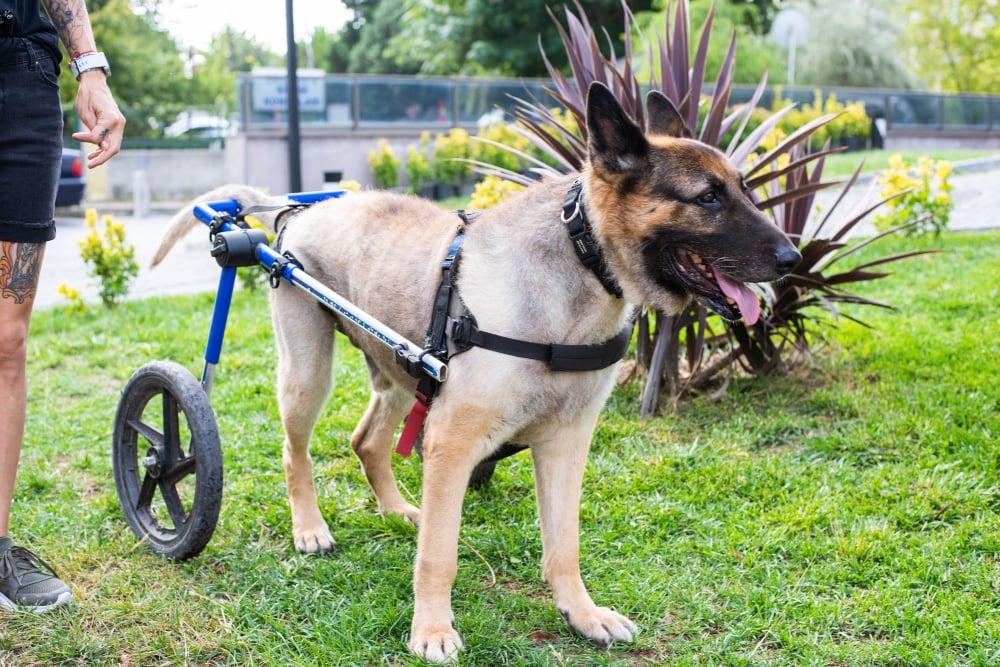Table of Contents
Physical rehabilitation for dogs is finally getting the respect it deserves. Gone are the days when rehab recommendations were limited to rest and leash walks. Now, rehabilitation for dogs combines the best that the fields of veterinary medicine and physical therapy have to offer.
Work together with your veterinarian
Pet parents play an integral role in dog rehabilitation. However, a veterinarian should always be involved in a dog’s care because, when used incorrectly, physical therapy exercises can cause pain or even worsen a dog’s injury. Veterinarians or specially trained veterinary physiotherapists design rehabilitation protocols based on a dog’s health history, physical examination, and a rehab exam that includes close analysis of a dog’s way of moving, measuring the range of motion of affected joints (called goniometry), and evaluation of muscle mass (Gulick measurements).
Types of physical therapy exercises for dogs
The goal of physical rehabilitation is to restore a dog’s mobility and function, relieve pain, and improve quality of life to the greatest extent possible. After the veterinarian has fully evaluated the dog, they will put together a combination of exercises and treatments to reach this goal. In the clinic, a veterinary rehab specialist can use a variety of equipment to get the process started. Exercises might include:
- Weaving through poles or cones
- Standing on rocker or wobble boards
- Walking over poles (cavaletti) set at varying heights or distances
- Standing on balance blocks that are slid in various directions
- Standing or lying on a slowly moving physioball
- Walking, jogging, or running on a treadmill
- Using an underwater treadmill to take advantage of water’s buoyancy, pressure, and resistance
- Swimming is sometimes an option, but because it is so strenuous for dogs and primarily involves the front legs it is only appropriate under certain circumstances.
The specialist will tweak each exercise to best suit a dog’s needs. For example, weights or resistance can be added to almost any exercise, or the incline of a treadmill ramp may be increased or decreased.
In many cases, the veterinarian will put together a list of exercises and treatments for a dog to continue with at home between rehab appointments. These may also be performed in the clinic if that is more appropriate.
- Cool compresses to reduce inflammation, swelling, and pain
- Warm compresses to promote circulation and relieve stiffness
- Passive range of motion exercises in which you gently flex and extend your dog’s joints to improve the circulation of joint fluid, which promotes healthy joint cartilage
- Light stretching in which you slowly increase a joint’s range of motion
- Active range of motion and stretching where the dog is encouraged to move their joints themselves
- Progressively longer or faster leash walks to improve cardiovascular function, strength, and endurance
- Walking up or down hills or steps
- Sit-to-stand or lay-to-stand exercises
- Zig-zag walking
- Walking in figure eights
- Stepping forward, backward, or side-to-side
Supplementing physical therapy exercises
The right combination of exercises and their duration, intensity, and other details all depend on a dog’s condition. To further complicate matters, many dogs benefit from additional treatments when undergoing physical rehabilitation, such as:
- Medications to relieve pain and inflammation, which can help a dog fully participate in rehab activities
- Nutritional supplements to reduce inflammation and promote joint health (omega-3 fatty acids, glucosamine, and chondroitin sulfate, for example)
- Acupuncture to stimulate the body’s natural healing abilities
- Low-level laser therapy to decrease pain, inflammation, and swelling
- Massage to promote circulation and tissue relaxation
- NMES (neuromuscular electrical stimulation) to increase strength
- TENS (transcutaneous electrical nerve stimulation) to reduce pain
- Therapeutic ultrasound to increase circulation, relax joints and muscles, and relieve pain
- Extracorporeal shockwave therapy to increase blood flow and decrease inflammation
- Assistive devices like harnesses, slings, protective nail covers or booties, nonslip floor coverings, ramps, and braces that help dogs move around safely
With so many moving parts, you can see why the involvement of a trained veterinary professional is so important in a dog’s leg injury rehabilitation. So, make that call to your veterinarian! Physical therapy may be the best way to get your dog on the road to recovery.








